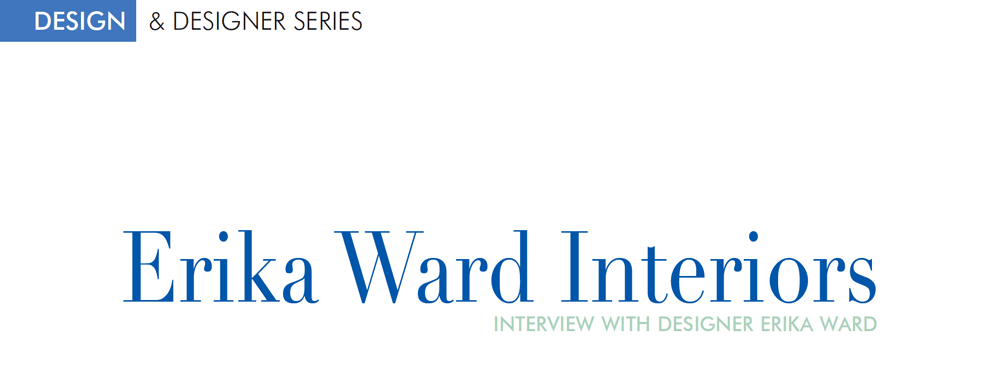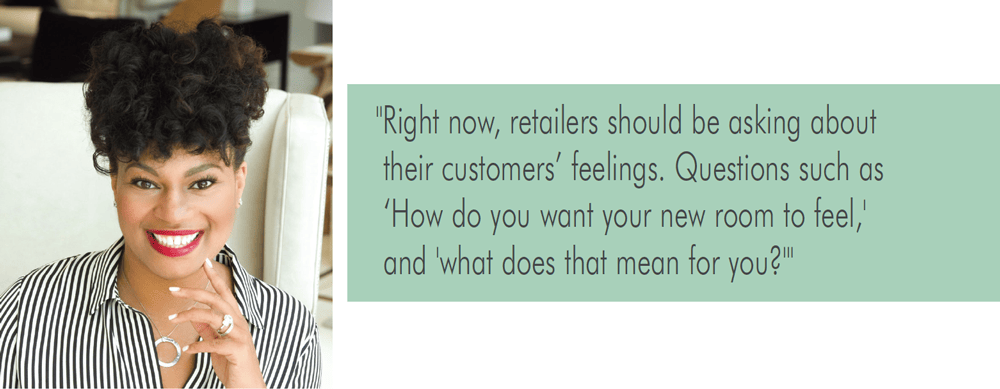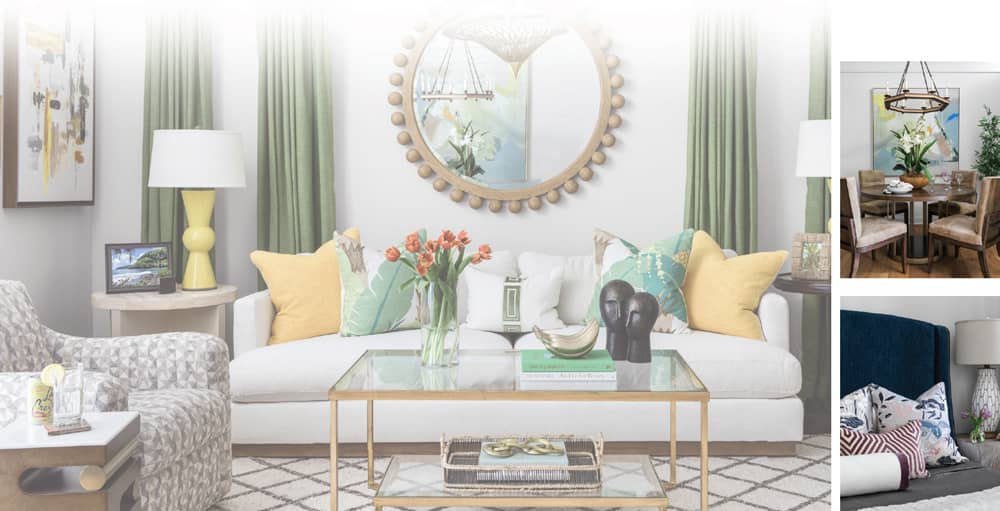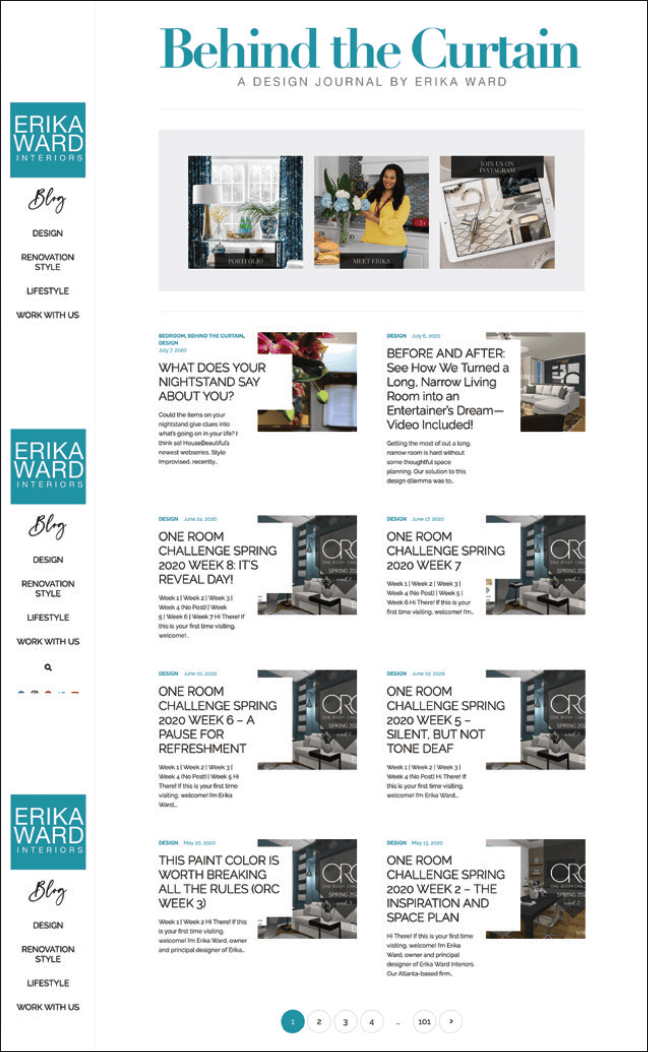
Interior designer,
blogger, brand ambassador and style spotter Erika Ward provides insight into what furniture consumers and families want and need right now.
In this installment of the Design & Designer series, Erika Hollinshead Ward, founder of Erika Ward Interiors shares her views on design, trends and how to effectively reach today’s consumers. Her design firm specializes in what she describes as a contemporary-meets-classic interior design aesthetic.
Erika is a long-time High Point Style Spotter who has been featured in Home and Décor, Jet Magazine, House Beautiful, Traditional Home, The Washington Post and her own popular blog, where she relates design news, gives expert advice and writes about renovations, entertaining and travel. Her practice serves design clients nationwide, but is rooted in the Atlanta area. She’s also worked closely with national brands as a spokesperson and brand ambassador.
Beautiful & Practical
Erika’s designs are beautiful and practical.
“My clients are typically busy successful professional people who call me after realizing that their decor doesn't reflect all the things achieved in life, nor does it nurture them. All of a sudden they want something good to happen and happen fast.
“I suppose that my background in finance,” she explained, ”lends a practical aspect to the designs I create for them. Rooms that are over the top need to be refreshed more often. At some point people grow tired of them and they may wonder, ‘Why in the world did I let that design firm do what they did?' So, I always design keeping in mind classic, timeless longevity."
She told Furniture World that people are used to buying individual furniture pieces or a room full of furniture at a furniture store. “When they hire a design firm, the investment adds up real fast. And so, if somebody entrusts me with $100,000 or $200,000, I make sure that they get designs they will love and that will last. If I become a steward of their money, it’s more likely that they will have good thoughts about me later, and will think, ‘I'm so glad I called her.’ A lot of my clients are left-brained, analytical, so this emphasis pulls at their heart strings!
“Good interior design is not just about creating a look, but really getting people to do a little bit of self-discovery without going to a therapist. It’s an opportunity to get them to focus inward to discover what they want, what they need, and really cater to those desires.

Questions Retailers Should be Asking
How might Furniture Retailers address the spirit of good interior design?
“Right now," she explained, "retailers should be asking about their customers’ feelings. Questions such as ‘How do you want your new room to feel,' and 'what does that mean for you?' How can we get you to fall in love with your house again?'
"Selling furnishings used to be about how consumers wanted their purchase to look. Did they like boho, something really modern and chic, or farmhouse?
“Our customers want to feel safe. They want to feel accomplished, successful and comfortable. A big part of our brand message at Erika Ward Interiors is to make client’s homes feel like sanctuaries. These sanctuaries can be for themselves, for their families or for guests who visit their newly designed homes.
“For our customers who have children, there’s always been a tension between having the family they always wanted and preventing their homes from looking like a romper room.”
Erika knows a lot about this. Her business persona is closely associated with her family and her ability to balance a growing design business with the responsibilities of tending to her family, which includes five school-age children.
“How can we help a client’s family life coexist with their desire to live a chic life?" she continued. "How in the world can that work? There are many ways that design-oriented furniture retailers can address these needs if they ask the right questions and listen. This includes finding out what customers already have in their homes and suggesting that they invest in performance fabrics and rugs."
Design Trends
Moving on to the subject of trends she observed, ”They can be money-drivers for interior designers and retailers. It’s easy to tell people that this or that look, style or color is on-trend. So, what do people do? They may buy it—sometimes based on these recommendations and other times reluctantly, because that's all they can find in the marketplace.”
Erika says that’s a shame because the observations of forecasters and influencers can limit choices.
Style Spotting
"Many furniture stores present as a little lackluster. They can feel lifeless and even a little boring. The same goes for their websites that can be item focused, lacking attractive lifestyle content and outdated. Retail websites don’t often have a lot of design personality, so it's more difficult for shoppers to picture pieces of furniture in their homes. Appealing to the masses has its place, but sometimes a niche marketing approach is better."
People don’t mind
spending more money on something if a
story about it helps them
to feel good about a purchase and better understand its value. |
When asked, based on her experience as a buyer and Style Spotter, what retailers can do to improve this lack of design excitement, she suggested they prepare by thinking about what’s missing in their product selections. "Ask their salespeople to keep track of what customers are asking for that’s not represented on their floors. What items can they purchase that will be unique to them and their brand? How might they increase excitement and complement what they already have on their floors to make it even better?”
Erika also suggested that buyers, while at Market, take more time to collect detailed information and stories about the products they purchase. “So many people today want to know the stories behind the designs," she explained. "They repeat that story when they have guests in their homes and on social media. That makes the pieces they purchased special and different from anything that anybody else has, or at least it can be made to seem that way.
“Collecting this information from manufacturers is time well spent. People don’t mind spending more money on something if a story helps them to feel good about a purchase and better understand its value.
“I always look to see what's new at High Point. I don’t just visit the people I already do business with. Markets are there to explore, find out what brands—especially international brands—have created that we are not yet seeing here. In that way I can incorporate some of that excitement into what we do to stand out at Erika Ward Interiors.”

Pictured above are images from Ward's showroom for clients and potential clients to visit. It’s not arranged like a typical furniture store, instead they feel like they’ve walked into someone's home.
|
From Finance to Design
“My path to becoming an interior designer started with a desire to become an architect, just like my grandfather. Instead, he encouraged me to study finance. Back then, I always did what I was told! Coming out of the University of Georgia, I worked for a full-service design, build, architecture and engineering firm as a project accountant. While doing financial reporting for the Georgia Aquarium, the largest aquarium in the world at that time, I developed a burning desire to do interior design.
“And so I started doing small projects for family and friends, eventually making the transition in 2009 to founding the full-service design firm, Erika Ward Interiors.”
Like a number of other prominent designers, Erika found her voice in home furnishings through blogging.
“I wrote about clients’ design projects and shared information about projects I was working on in my own home. At the same time, I attended industry events, at first locally in Atlanta. These also found their way into my blog http://erikaward.com/blog. That in turn, helped me to earn a reputation for having a finger on the pulse of home furnishings design trends.
“The interior design industry allowed me to scale my business to accommodate family duties. In the very beginning, I did more consulting work, providing customized design services for core clients. Over time, this generated a huge referral base of people who had a good experience. They shared these experiences with friends, family and neighbors—across the operating table, at the golf club and on the soccer field."
Designers in Retail Stores
Are there opportunities for retailers to integrate interior designers into their business models? Erica thinks, “Absolutely! There are a lot of sole proprietor interior designers who have talent and just want to design. I’m not saying that these creators aren’t good business people, but they often end up doing more administrative tasks than actual design work.
"Working with a furniture retailer can be the perfect solution. Retailers take care of administrative tasks and designers spend their time doing what they do best."
She says that this can change the nature of the retail conversation. “Instead of trying to sell that sofa or chair, the focus changes to which of these pieces best suit the client. It can be a beautiful collaboration.”

Ward's popular blog shares design news, expert design advice, plus advice about renovations, entertaining and travel.
|
Trends in Room Use
“Especially since the pandemic, people are looking for more comfortable upholstered pieces and home office furnishings. Paint, wall coverings and window coverings are also selling well because everyone wants to give their rooms a refresh.
“True southerners refuse to let go of their dining rooms, but sometimes my clients, when asked, let me know that they mostly use them just on holidays, maybe three or four times a year.
“The current situation has forced many people to use every bit of space in their homes, so dining rooms are being converted to home offices spaces. It’s an opportunity for furniture retailers."
The Future
Before the pandemic hit, Ward had plans to expand into retail, but now these plans are on hold. “ I opened a showroom that clients and potential clients can visit. It’s not arranged like a typical furniture store. When they walk into our showroom, it feels like they’ve walked into someone's home. There is an entryway, living, dining and kitchen areas. Also, we created a closed-off bedroom, wet bar, study, as well as a resource room, a couple of bathrooms and space to make presentations. I had plans to expand into small retail, but had to scale back because of COVID-19. So, it’s appointment-only until next year."
Ward is also designing a wellness room in Seasonal Living Magazine's 20,000-square-foot modern luxury virtual designer showhouse—the first luxury designer showhouse, both tourable and shopable from the comfort of home. Unconstrained by the real world concerns of budget and product availability, participating interior designers have complete creative control to showcase sponsoring brands with a focus on wellness and sustainability. Built entirely in the virtual world, with no real world counterpart, it sits on a 20-acre estate in Malibu, California, with beautiful views of the Pacific Ocean. "I'm super excited about this opportunity," she concluded.
More information on this designer showhouse can be found at: http://bit.ly/DesignerShowhouse.
Furniture World is the oldest, continuously published trade publication in the United States. It is published for the benefit of furniture retail executives. Print circulation of 20,000 is directed primarily to furniture retailers in the US and Canada. In 1970, the magazine established and endowed the Bernice Bienenstock Furniture Library (www.furniturelibrary.com) in High Point, NC, now a public foundation containing more than 5,000 books on furniture and design dating from 1620. For more information contact editor@furninfo.com.